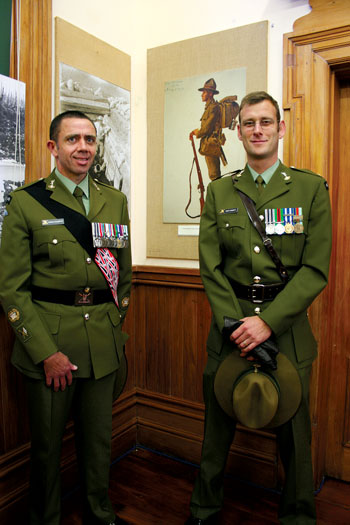
Otaki’s Heritage Bank Museum has opened the latest exhibition commemorating 100 years since the beginning of World War 1 and the four years of conflict that followed.
The opening formalities were held outside at the front of the museum building, with visiting dignitaries representing the Kapiti Coast District Council, Otaki RSA, and members of the Defence Forces. Otaki RSA president Colin Robinson spoke of New Zealand’s close association with Britain and the British Empire in 1914, the immediate response from the call to arms of the country’s menfolk and the horrific statistics of the NZ forces. Rear Admiral (Retired) David Ledson read the Proclamation of War, as sent from England and read by then Governor General Lord Liverpool after Britain declared war on Germany on August 4 1914.
New Zealand responded immediately. With limited military training, and only 11 days later, 1400 troops were sent to occupy German (Eastern) Samoa followed, on October 16, by ten ships carrying 8400 men and 3800 horses on their way to Egypt.
From a population of a little over one million, 103,000 New Zealander’s served overseas and took with them 10,000 horses. 18,500 died during the years of battle, 2,700 at Gallipoli, 12,500 in France and Belgium in the battles of Somme, Ypre, Passchendale and Messines. Of the 50,000 wounded, many were injured again after being returned to the front line. Thousands more suffered in their later years, because of the effects of the war. Of the Otaki men who volunteered for service, 81 died.
The 1914 WW1 saw the formation of the first Native Contingent, later known as the Maori Pioneer Battalion and in WW2 it became the Maori Battalion.
After the formalities people moved into the museum to see the exhibits which included the letter sent to Lieutenant Charles Atmore from King George V congratulating him on his service and awards – he served with the 2nd Battalion Otago Regiment.He was awarded the Military Cross (1914-15 Star) British War Medal 1914-18, the Victory Medal 1914-19 and the 1914 Star after the August-November retreat from Mons. Other personal memorabilia included letters and cards sent home, weapons, photographs and kitbag equipment.
Following the viewing of the exhibits afternoon tea was served at the RSA rooms.
The exhibition will run into next year, with some of the exhibits being changed during this time.
The museum is open Thursday, Friday and Saturdays between 10am and 2pm

